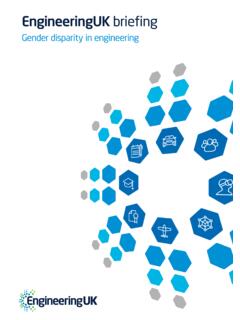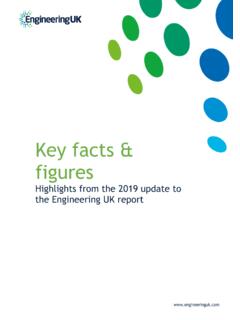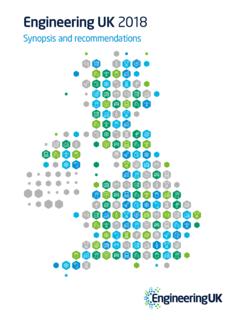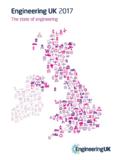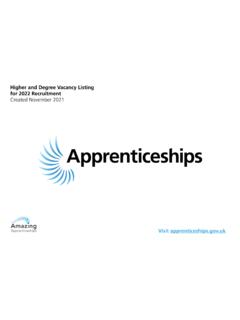Transcription of Engineering UK 2020
1 Engineering UK 2020 Educational pathways into engineeringEngineering UK 2020 Educational pathways into engineeringAuthors Luke Armitage Senior Research Analyst, EngineeringUKMollie Bourne Research and Impact Manager, EngineeringUKJess Di Simone Research Officer, EngineeringUKAnna Jones Research Officer, EngineeringUKStephanie Neave Head of Research, EngineeringUKEngineeringUK would like to express sincere gratitude and special thanks to the following individuals, who contributed thought pieces or acted as critical readers for this report:Amanda Dickins Head of Impact and Development, STEM LearningTeresa Frith Senior Skills Policy Manager, Association of Colleges Ruth Gilligan Assistant Director for Equality Charters, AdvanceHEAimee Higgins Director of Employers and Partnerships, The Careers & Enterprise CompanyPeter Mason Policy Manager, EU research and innovation, Universities UK International Rhys Morgan Director of Engineering and Education, Royal Academy of Engineering Olly Newton Executive Director, Edge FoundationWe would also like to thank the organisations and individuals who provided case studies, a complete list of whom can be found at the back cover of this analyses for this report started before the pandemic began.
2 In light of the current and rapidly changing educational environment, EngineeringUK has not sought to update our findings. Instead, Educational Pathways into Engineering provides a comprehensive picture of where we were in early 2020, detailing the trends in science, technology, Engineering and maths (STEM) educational participation and attainment across academic and technical pathways into Engineering . This intelligence is valuable for several reasons. First, it shows the encouraging progress made to this point. Across the UK, GCSE and A level entries in many Engineering -facilitating subjects have been on the rise, as has the number of first degree undergraduate entrants to Engineering and technology courses. Technical education reforms have centred on better preparing students for the world of work, especially in areas for which there are skills shortages, such as STEM. But perhaps more importantly, this report highlights the barriers that existed prior to the pandemic and that are now likely to make it more challenging to increase the number and diversity of young people choosing Engineering .
3 Over the coming months, we will need to work together to quickly understand how the following issues are evolving and what can be done to mitigate them: There is underrepresentation of certain groups progressing into Engineering , particularly female students and those from socioeconomically disadvantaged backgrounds. There are also unequal outcomes for those from minority ethnic backgrounds that cannot be explained by typical factors. School closures during the pandemic are likely to accentuate social disadvantages and introduce new ones. The use of predicted grades risks embedding societal biases in student outcomes. Our focus must be on understanding what causes underrepresentation and tackling it at every educational stage. Engineering has little curriculum presence and there is limited awareness and understanding of it among young people and their influencers. We must improve knowledge of Engineering . We have an acute shortage of STEM teachers and they are likely to experience new pressures and challenges in the year ahead.
4 We need to support teachers and schools to deliver high quality STEM education and careers Ambitious plans to expand technical education are heavily reliant on employers and may not have considered the specific requirements of Engineering . It will be even harder to deliver industry placements in this time of economic volatility and social distancing. Our dependency on international staff and students in higher education, particularly in Engineering , also makes the UK vulnerable to the terms of departure from the EU and this is more worrying in light of the pandemic. We must analyse these impacts on the education system and ensure it is fit to cultivate the skills needed for the UK, now and into the future. We urge those in education, government and industry to work together to foster the critical Engineering and technology skills needed for the UK to be a leader in innovation and improve societal and economic resilience and environmental sustainability.
5 We hope our findings ser ve to inform these endeavours and thank all the organisations and individuals who contributed invaluable insight via critical review, case studies and thought pieces to this report. EngineeringUK aims to grow the collective impact of work across the sector to help young people understand what Engineering is, how to get into it, and be motivated and able to access the educational and training opportunities to pursue a career in the profession. Engineering is a varied, stimulating and valuable career and we need to work harder than ever to ensure that it is accessible for the current generation of young people both for their own life chances and so that we have a diverse and insightful workforce that enables the UK to thrive. A central part of EngineeringUK s work is to provide educators, policy-makers, industrialists and others with the most up-to-date analyses and insight. Since 2005, our EngineeringUK State of Engineering report has portrayed the breadth of the sector, how it is changing and who is working within it, as well as quantifying students on educational pathways into Engineering and considering whether they will meet future workforce needs.
6 Despite numerous changes of government and educational policy, the 2008 recession and the advent of Brexit, the need for the UK to respond to the COVID-19 pandemic has provided the most uncertain and challenging context to date for our Hilary LeeversChief ExecutiveEngineeringUKExecutive Summary ..11 Harnessing the talent pool ..7 Introduction ..8 STEM educational pathways: an overview ..10 Facilitators and barriers in STEM educational choices ..14 Government strategies to plug the skills gap ..27 Wider sector initiatives to increase STEM participation ..29 Summary ..322 Secondary education ..35 2 .1 Context ..36 The secondary education landscape in England ..37 STEM GCSEs in England, Wales and Northern Ireland ..44 STEM National 5s in Scotland ..48 STEM A levels in England, Wales and Northern Ireland ..50 STEM Highers and Advanced Highers in Scotland.
7 53 STEM teacher shortages ..553 Further education and apprenticeships ..63 Context ..64 The further education landscape ..65 T levels ..69 Higher technical qualifications ..74 Teaching in the further education sector ..74 apprenticeship reforms ..77 apprenticeship trends in England ..82 apprenticeship trends in Scotland, Wales and Northern Ireland ..934 Higher education ..101 Context ..102 Engineering and technology in higher education ..105 Engineering and technology students by level of study ..107 Engineering and technology students by gender Context ..114 Engineering and technology students by ethnicity ..118 Engineering and technology students by socioeconomic status ..122 Engineering and technology students by disability ..126 Intersectionality ..128 Engineering and technology students by domicile ..130 Contents1 Executive Summary Executive summarySTEM education has the potential to address the UK Engineering sector s long-standing skills shortage.
8 The extent to which this potential is harnessed and the next generation of engineers cultivated depends on the educational opportunities presented to young people and the choices they then make. In recent years, there has been a strong policy emphasis on using education as a means to better prepare students for the world of work, especially in areas for which there are skills shortages, such as STEM. This report details the trends in STEM educational participation and attainment across both academic and technical pathways into Engineering . It also highlights the progress that has been made and the future opportunities and challenges for the Engineering influencing young peopleThe UK education system is complex, offering a range of qualifications and subjects at each stage of a young person s educational journey. Each stage represents a branching point at which young people are presented with a series of choices.
9 These choices are, in turn, shaped by many factors, including their understanding of the options available, the opportunities presented to them and their own capabilities and personal motivations. Evidence suggests that the underrepresentation of certain groups in Engineering , such as women, is in part driven by differences in these factors. However, there is much more work to be done to understand how these can be effectively and anticipated future attainment clearly factors into young people s educational decision-making processes. However, pass rates for STEM subjects and non-STEM subjects at GCSE and A level are broadly similar, suggesting that young people are not opting out of STEM qualifications due to disproportionate levels of underachievement during the compulsory educational stages. A young person s perception and knowledge of Engineering is also likely to be a factor in their decision to pursue a career in the profession.
10 Unfortunately, there is a widespread lack of awareness about Engineering . Almost half (47%) of 11 to 19 year olds said they knew little or almost nothing about what engineers do. Worse, this limited knowledge is often distorted; not only is Engineering seen as dif ficult, complicated and dir ty, it is often also considered a man s profession. Our findings show young people often doubt their ability to succeed in STEM. For example, 62% of 16 to 17 year olds in the UK felt that subjects like science and maths were more dif ficult than non-STEM subjects. Swathes of research show that girls in particular perceive their capability in STEM as unrealistically low a striking finding, given that girls outperform boys in most STEM subjects at GCSE and A lack of knowledge about relevant STEM educational pathways can also discourage young people from pursuing Engineering careers. In 2019, just 39% of young people aged 14 to 16 said they know what they need to do next in order to become an engineer and this figure has remained fairly static over time.
